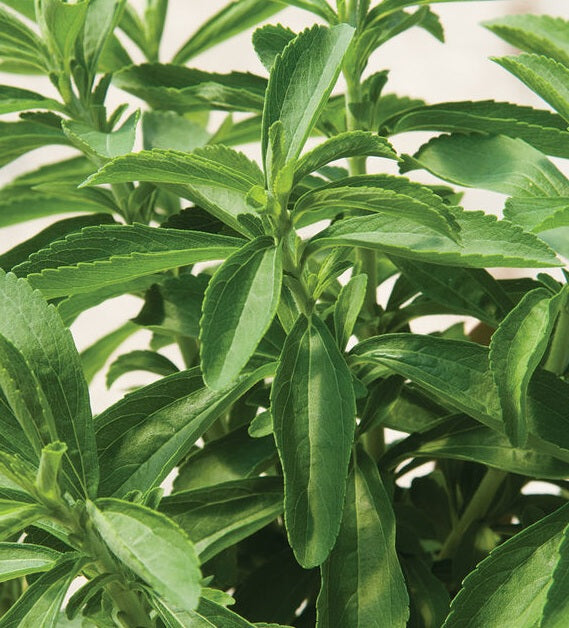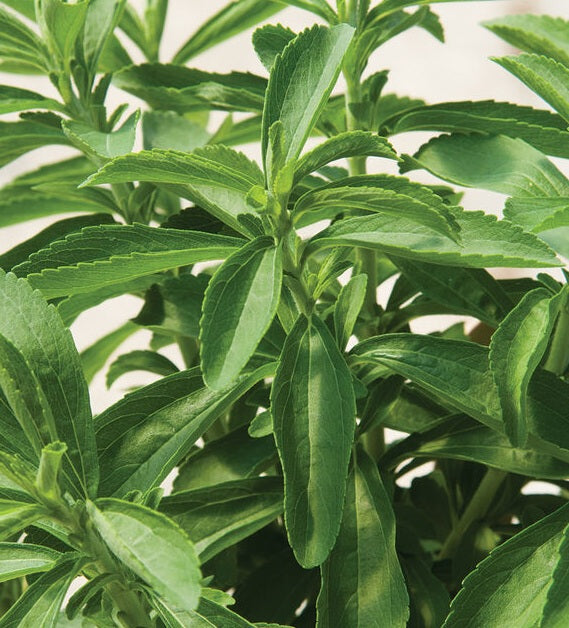Stevia
Stevia
Packet Size: 10 seeds
Couldn't load pickup availability
Stevia (Stevia rebaudiana) is grown as an annual for its soft green leaves, upright habit, and loose clusters of tubular white flowers later in the season — a lovely and unusual ornamental. Also known as ‘Sweet Herb’, it’s ideal for pots or a spot in the herb garden. Although it's widely used as a natural sweetener elsewhere, UK regulations currently don’t allow it to be grown for human consumption, grow it as a foliage plant. More on its traditional uses and background below.
🌸 Flowering: August to October: grow as a foliage plant
📏 Height: to 30cm
🌿Tender Perennial, grow as an Annual
SOW: surface sow onto moist compost and just cover. Keep the humidity high (a plastic bag or propagator works well) and maintain warmth at 25–27°C. Germination can be erratic and may take 1–3 weeks. Pot on when large enough to handle and keep under protection.
You can sow at any time if growing with protection, or sow in spring if you plan to plant them outside.
GROW: once frost risk has passed, harden off and plant out in full sun. Keep the soil moist and mulch to help retain moisture. Stevia grows well in containers or in the ground with your other herbs. Pinch back bushy plants to encourage fresh leafy growth. If growing in pots, you can bring them indoors to overwinter in a warm spot. Cut back flowering stems to keep the plant productive.
ENJOY: a tender perennial that can survive with the right protection, but best treated as a half-hardy annual in UK gardens. Pop it somewhere warm and sheltered — its light, airy flowers and soft leaves make it a charming addition.
📌USES:
Great garden plant
- Grow it as an annual for its soft green leaves, upright habit and loose clusters of tubular white flowers
- Bushy up to 30cm
- Prefers a sheltered site, full or part sun, moist but well draining soil
- Plant out after all danger of frost is over – although deciduous in its native home it will die back in freezing temperature (thus grow as a half hardy annual)
Botanical information
- In the botanical world, Stevia comprises a genus of about 240 species of herbs and shrubs in the plant family, Asteraceae. Among all those species, however, there is only one that exhibits a high level of sweetness: that is Stevia rebaudiana.
Traditional Uses
- Stevia is native to Paraguay and Brazil where it has been used for centuries not only to sweeten food but also to treat various ailments and diseases
Traditional Harvesting
- Leaves can be picked as required.
- Leaves may be eaten straight from the plant or dried.
- Leaves can be dried quickly in a warm oven, dried leaves should be stored in an airtight jar.
- Dried leaves can be ground up as needed to powder, this could be used in baking as a sugar replacement
- Sweetness is only released when eaten fresh or when steeped in hot water for example a single leaf in a hot cup of tea will bring a sweet, earthy flavour
Modern Thoughts
- In 1900, Paraguayan chemist Ovidio Rebaudi discovered that stevia rebaudiana’s leaves contained compounds called steviol glycosides. Furthermore, when extracted and refined, these compounds were found to be 200 times sweeter than processed sugar.
- Stevia had received a lot of interest as it only takes a small amount of stevia to produce the same level of sweetness as sucrose. And since humans are unable to metabolize steviol glycosides, the extract was deemed not only calorie-free, but also didn’t raise blood sugar levels when digested.
CAUTION: to date Stevia is not approved in the UK or Europe for use in food due to the lack of generally accepted specifications

Collapsible content
Sowing
- Mar
- Apr
- May
Harvesting / Flowering
- Jun
- Jul
- Aug
- Sep

